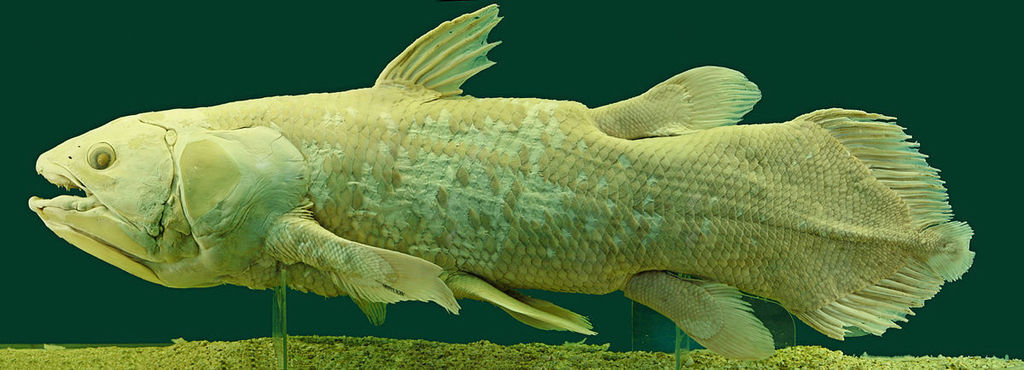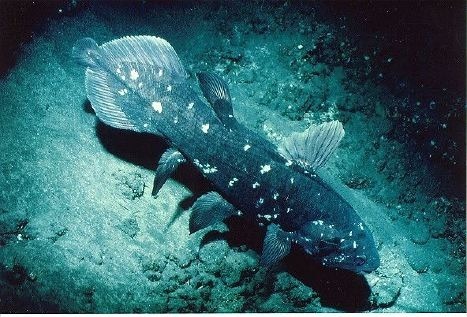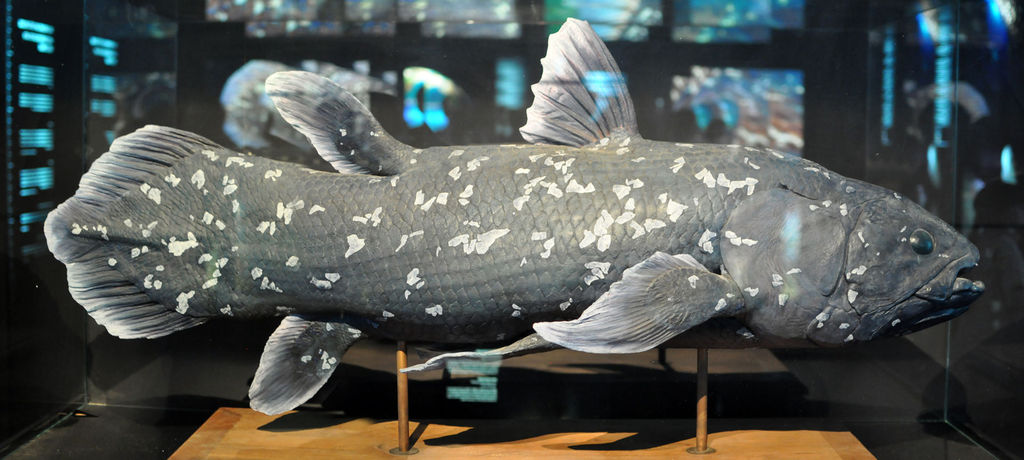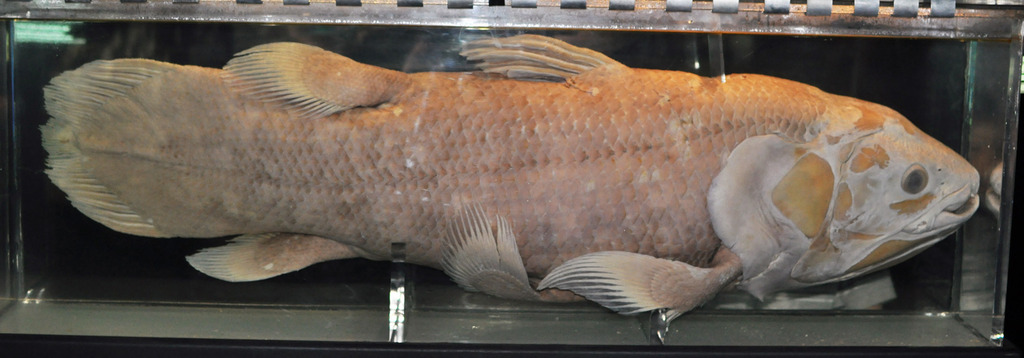新規記事の投稿を行うことで、非表示にすることが可能です。
2017年08月24日
2017年08月23日
Diving With The Dinosaur Fish (Full Documentary)
Diving With The Dinosaur Fish (Full Documentary)
https://youtu.be/SL8RH4HPn2g
Diving With The Dinosaur Fish (Full Documentary)
https://youtu.be/SL8RH4HPn2g
Published on Mar 28, 2016
Diving With The Dinosaur Fish
Diving With the Dinosaur Fish Deep-sea documentaries often turn out to be disappointing TV spectacles, a mixture of silt, flashing lights and, occasionally, something slippery finning into the shadows. This, though, is pin-sharp, an expertly shot portrait of the weird twilight habitat found 120m beneath the South African waves. The footage is gorgeous; the science is even more intriguing. A team of extreme divers is searching for an ancient creature called a coelacanth (pronounced “see-low-canth”), said to be the missing link in the chain of evolution that led from the sea to dry land, fish to mammals and, 380 million years later, us. There’s something charmingly benign about this creature that time forgot, with its lips gnarled like a disgruntled sea captain and its stubby fins – the precursor to limbs – rowing aimlessly through the water. The story of the `living fossil' of 1938, when the impossible occurred off the South African coast and a fish believed to have been extinct since the dinosaur age was found.
Category Howto & Style
License Standard YouTube License
=======================
NOTE
シーラカンス Coelacanth
https://en.wikipedia.org/wiki/Coelacanth#/media/File:Latimeria_Chalumnae_-_Coelacanth_-_NHMW.jpg


シーラカンス:Wikipedia
https://en.wikipedia.org/wiki/Coelacanth#/media/File:Latimeria_Chalumnae_-_Coelacanth_-_NHMW.jpg
https://ja.wikipedia.org/wiki/%E3%82%B7%E3%83%BC%E3%83%A9%E3%82%AB%E3%83%B3%E3%82%B9
Coelacanth:Wikipedia
https://en.wikipedia.org/wiki/Coelacanth
West Indian Ocean coelacanth:Wikipedia
https://en.wikipedia.org/wiki/West_Indian_Ocean_coelacanth
https://en.wikipedia.org/wiki/Coelacanth#/media/File:Latimeria_chalumnae_replica.jpg

Coelacanth (Latimeria chalumnae) caught on 21 January 1965, next to Mutsamudu (Anjouan, Comoro Islands).C36
https://en.wikipedia.org/wiki/West_Indian_Ocean_coelacanth#/media/File:Latimeria_chalumnae.jpg

===================================================
===================================================


===================================================
===================================================
https://youtu.be/SL8RH4HPn2g
Diving With The Dinosaur Fish (Full Documentary)
https://youtu.be/SL8RH4HPn2g
Published on Mar 28, 2016
Diving With The Dinosaur Fish
Diving With the Dinosaur Fish Deep-sea documentaries often turn out to be disappointing TV spectacles, a mixture of silt, flashing lights and, occasionally, something slippery finning into the shadows. This, though, is pin-sharp, an expertly shot portrait of the weird twilight habitat found 120m beneath the South African waves. The footage is gorgeous; the science is even more intriguing. A team of extreme divers is searching for an ancient creature called a coelacanth (pronounced “see-low-canth”), said to be the missing link in the chain of evolution that led from the sea to dry land, fish to mammals and, 380 million years later, us. There’s something charmingly benign about this creature that time forgot, with its lips gnarled like a disgruntled sea captain and its stubby fins – the precursor to limbs – rowing aimlessly through the water. The story of the `living fossil' of 1938, when the impossible occurred off the South African coast and a fish believed to have been extinct since the dinosaur age was found.
Category Howto & Style
License Standard YouTube License
=======================
NOTE
シーラカンス Coelacanth
https://en.wikipedia.org/wiki/Coelacanth#/media/File:Latimeria_Chalumnae_-_Coelacanth_-_NHMW.jpg


シーラカンス:Wikipedia
https://en.wikipedia.org/wiki/Coelacanth#/media/File:Latimeria_Chalumnae_-_Coelacanth_-_NHMW.jpg
https://ja.wikipedia.org/wiki/%E3%82%B7%E3%83%BC%E3%83%A9%E3%82%AB%E3%83%B3%E3%82%B9
Coelacanth:Wikipedia
https://en.wikipedia.org/wiki/Coelacanth
West Indian Ocean coelacanth:Wikipedia
https://en.wikipedia.org/wiki/West_Indian_Ocean_coelacanth
https://en.wikipedia.org/wiki/Coelacanth#/media/File:Latimeria_chalumnae_replica.jpg

Coelacanth (Latimeria chalumnae) caught on 21 January 1965, next to Mutsamudu (Anjouan, Comoro Islands).C36
https://en.wikipedia.org/wiki/West_Indian_Ocean_coelacanth#/media/File:Latimeria_chalumnae.jpg

===================================================
===================================================
===================================================
===================================================
Coelacanth: A Fish That Time Forgot [Natural History Documentary] | Wild Things
Coelacanth: A Fish That Time Forgot [Natural History Documentary] | Wild Things
https://youtu.be/dHkunoQPZlE
Coelacanth: A Fish That Time Forgot
[Natural History Documentary] | Wild Things
https://youtu.be/dHkunoQPZlE
Published on Mar 25, 2017
When a curious fish was found by fishermen on the Indian Ocean coast of South Africa and passed to the curator of the local museum, Darwin’s predicted ‘living fossil’ appeared to have surfaced. The eerily splendid coelacanth, now 400 million years old, called into question many of our established beliefs about evolution.
Click here for more documentaries: http://bit.ly/2gSPaf6
For exclusive clips, follow us Facebook: facebook.com/wildthingschannel
Any queries, please contact us at: wildthings@littledotstudios.com
Category Pets & Animals
License Standard YouTube License
=======================
NOTE
シーラカンス Coelacanth
https://en.wikipedia.org/wiki/Coelacanth#/media/File:Latimeria_Chalumnae_-_Coelacanth_-_NHMW.jpg


シーラカンス:Wikipedia
https://en.wikipedia.org/wiki/Coelacanth#/media/File:Latimeria_Chalumnae_-_Coelacanth_-_NHMW.jpg
https://ja.wikipedia.org/wiki/%E3%82%B7%E3%83%BC%E3%83%A9%E3%82%AB%E3%83%B3%E3%82%B9
Coelacanth:Wikipedia
https://en.wikipedia.org/wiki/Coelacanth
West Indian Ocean coelacanth:Wikipedia
https://en.wikipedia.org/wiki/West_Indian_Ocean_coelacanth
https://en.wikipedia.org/wiki/Coelacanth#/media/File:Latimeria_chalumnae_replica.jpg

Coelacanth (Latimeria chalumnae) caught on 21 January 1965, next to Mutsamudu (Anjouan, Comoro Islands).C36
https://en.wikipedia.org/wiki/West_Indian_Ocean_coelacanth#/media/File:Latimeria_chalumnae.jpg

===================================================
===================================================


===================================================
===================================================
https://youtu.be/dHkunoQPZlE
Coelacanth: A Fish That Time Forgot
[Natural History Documentary] | Wild Things
https://youtu.be/dHkunoQPZlE
Published on Mar 25, 2017
When a curious fish was found by fishermen on the Indian Ocean coast of South Africa and passed to the curator of the local museum, Darwin’s predicted ‘living fossil’ appeared to have surfaced. The eerily splendid coelacanth, now 400 million years old, called into question many of our established beliefs about evolution.
Click here for more documentaries: http://bit.ly/2gSPaf6
For exclusive clips, follow us Facebook: facebook.com/wildthingschannel
Any queries, please contact us at: wildthings@littledotstudios.com
Category Pets & Animals
License Standard YouTube License
=======================
NOTE
シーラカンス Coelacanth
https://en.wikipedia.org/wiki/Coelacanth#/media/File:Latimeria_Chalumnae_-_Coelacanth_-_NHMW.jpg


シーラカンス:Wikipedia
https://en.wikipedia.org/wiki/Coelacanth#/media/File:Latimeria_Chalumnae_-_Coelacanth_-_NHMW.jpg
https://ja.wikipedia.org/wiki/%E3%82%B7%E3%83%BC%E3%83%A9%E3%82%AB%E3%83%B3%E3%82%B9
Coelacanth:Wikipedia
https://en.wikipedia.org/wiki/Coelacanth
West Indian Ocean coelacanth:Wikipedia
https://en.wikipedia.org/wiki/West_Indian_Ocean_coelacanth
https://en.wikipedia.org/wiki/Coelacanth#/media/File:Latimeria_chalumnae_replica.jpg

Coelacanth (Latimeria chalumnae) caught on 21 January 1965, next to Mutsamudu (Anjouan, Comoro Islands).C36
https://en.wikipedia.org/wiki/West_Indian_Ocean_coelacanth#/media/File:Latimeria_chalumnae.jpg

===================================================
===================================================
===================================================
===================================================
5 Bizarre Facts About the Coelacanth | What the Stuff?!
5 Bizarre Facts About the Coelacanth | What the Stuff?!
https://youtu.be/3LXRzvP0D_0
5 Bizarre Facts About the Coelacanth
| What the Stuff?!
https://youtu.be/3LXRzvP0D_0
Published on Nov 21, 2015
The coelacanth is an order of bottom-dwelling, carnivorous ocean fish that grow up to 6 and a half feet (2 meters) long and weigh up to 200 pounds (91 kilograms). But they’re not just huge and crazy ugly – they’re also one of the most interesting animals in all of biology.
Coelacanth Article:
http://animals.howstuffworks.com/enda...
Subscribe http://bit.ly/1AWgeM7
Twitter https://twitter.com/HowStuffWorks
Facebook https://www.facebook.com/HowStuffWorks
Google+ https://plus.google.com/+howstuffworks
Website http://www.howstuffworks.com
Watch More https://www.youtube.com/HowStuffWorks
Music:
"Venus" by Jahzzar
Video Attribution:
FOSSIL FISH FOUND ALIVE ( diving with dinosaur fish )
https://www.youtube.com/watch?v=v8hug...
Transcript:
The coelacanth (SEEL-uh-kanth) is an order of bottom-dwelling, carnivorous ocean fish that grow up to 6 and a half feet (2 meters) long and weigh up to 200 pounds (91 kilograms). But they’re not just huge and crazy ugly – they’re also one of the most interesting animals in all of biology.
People used to think coelacanths were extinct. Imagine if tomorrow scientists discovered that a small herd of triceratops were still alive, living somewhere in the rain forests of South America. Well, trade that genus of dinosaur for an order of lobe-finned fish, and that’s pretty much what happened with the coelacanth. Up until the 1930s, scientists only knew about the coelacanth from the fossil record -- everyone thought that these fish had been extinct for about 65 million years! But in December 1938, a South African museum curator named Marjorie Courtenay-Latimer got a call from a fishing fleet manager asking if she wanted to take a look at a selection of fish caught near the mouth of the Chalumna River off the coast of South Africa. When Courtenay-Latimer examined the haul, she found a strange, 5-foot-long, blue-gray fish with fins that resembled legs. Together, Courtenay-Latimer and a nearby chemistry professor and amateur ichthyologist named J.L.B. Smith worked to identify the newly discovered fish, and realized that the order of Coelacanth had survived -- unrecognized, unappreciated and unloved -- into the present day. Today there are only two known species of coelacanth left alive: the Latimeria menadoensis and Latimeria chalumnae – both get their genus name from Courtenay-Latimer. No one knows exactly how many specimens of each species are left on Earth, but scientists consider both to be rare and threatened.
They’re cave-dwellers. The known coelacanth populations left alive today can usually be found near caves around deep, rocky areas off the coast of volcanic islands. During the daytime, they usually hide inside the caves. At night, they emerge to hunt ... which they do by passively floating in the water, waiting for favorite snacks like squid and octopus to drift by.
Coelacanths have tiny brains. The brain of an adult coelacanth takes up less than 1.5 percent of its cranial cavity; the other 98.5 percent of the cavity is literally just full of fat. You can chalk this up to something called “negative allometric growth” – when an organ doesn’t grow as fast as the rest of the body. When a coelacanth is young, its brain takes up much more of the cranial cavity. But as the fish grows bigger, the brain doesn’t grow proportionally – the skull keeps getting bigger, but the brain doesn’t.
They’re unique among living fish. Unlike any other living fish species, coelacanths have a special “intracranial joint” that works like a “hinge” for the anterior portion of their skulls. Together with a muscle underneath the upper jaw known as the basicranial muscle, this hinge helps the coelacanth generate a stronger bite force. They also have a unique “rostral organ” in the nose, which they use as part of their electrosensory system.
Coelacanth meat is disgusting and will make you sick. Have you ever been curious to taste the meat of an endangered ancient animal? Sure, we all have, but let us insist: You do not want to eat a coelacanth. Its meat has been described as slimy, oily and mucus-covered, with a foul smell -- not unlike the stuff in my college fridge. Even better, Coelacanth flesh is full of urea, which is a nitrogen-based compound that your kidneys cleanse from your blood and you then excrete in your pee. So it’s kind of like eating greasy urine-flesh. But it’s also full of wax esters, which are molecules of indigestible junk that your body will probably discharge in a flood of unstoppable oily diarrhea. Local fish-catchers call it “Gombessa,” meaning “taboo” – suggesting there’s cultural knowledge that this fish is not good for eating. So if Captain D’s jumps on the irony-based food bandwagon and launches an ad campaign for a double-fried coelacanth taco or whatever... consider yourself warned.
Category Education
License Standard YouTube License
=======================
NOTE
シーラカンス Coelacanth
https://en.wikipedia.org/wiki/Coelacanth#/media/File:Latimeria_Chalumnae_-_Coelacanth_-_NHMW.jpg


シーラカンス:Wikipedia
https://en.wikipedia.org/wiki/Coelacanth#/media/File:Latimeria_Chalumnae_-_Coelacanth_-_NHMW.jpg
https://ja.wikipedia.org/wiki/%E3%82%B7%E3%83%BC%E3%83%A9%E3%82%AB%E3%83%B3%E3%82%B9
Coelacanth:Wikipedia
https://en.wikipedia.org/wiki/Coelacanth
West Indian Ocean coelacanth:Wikipedia
https://en.wikipedia.org/wiki/West_Indian_Ocean_coelacanth
https://en.wikipedia.org/wiki/Coelacanth#/media/File:Latimeria_chalumnae_replica.jpg

Coelacanth (Latimeria chalumnae) caught on 21 January 1965, next to Mutsamudu (Anjouan, Comoro Islands).C36
https://en.wikipedia.org/wiki/West_Indian_Ocean_coelacanth#/media/File:Latimeria_chalumnae.jpg

===================================================
===================================================


===================================================
===================================================
https://youtu.be/3LXRzvP0D_0
5 Bizarre Facts About the Coelacanth
| What the Stuff?!
https://youtu.be/3LXRzvP0D_0
Published on Nov 21, 2015
The coelacanth is an order of bottom-dwelling, carnivorous ocean fish that grow up to 6 and a half feet (2 meters) long and weigh up to 200 pounds (91 kilograms). But they’re not just huge and crazy ugly – they’re also one of the most interesting animals in all of biology.
Coelacanth Article:
http://animals.howstuffworks.com/enda...
Subscribe http://bit.ly/1AWgeM7
Twitter https://twitter.com/HowStuffWorks
Facebook https://www.facebook.com/HowStuffWorks
Google+ https://plus.google.com/+howstuffworks
Website http://www.howstuffworks.com
Watch More https://www.youtube.com/HowStuffWorks
Music:
"Venus" by Jahzzar
Video Attribution:
FOSSIL FISH FOUND ALIVE ( diving with dinosaur fish )
https://www.youtube.com/watch?v=v8hug...
Transcript:
The coelacanth (SEEL-uh-kanth) is an order of bottom-dwelling, carnivorous ocean fish that grow up to 6 and a half feet (2 meters) long and weigh up to 200 pounds (91 kilograms). But they’re not just huge and crazy ugly – they’re also one of the most interesting animals in all of biology.
People used to think coelacanths were extinct. Imagine if tomorrow scientists discovered that a small herd of triceratops were still alive, living somewhere in the rain forests of South America. Well, trade that genus of dinosaur for an order of lobe-finned fish, and that’s pretty much what happened with the coelacanth. Up until the 1930s, scientists only knew about the coelacanth from the fossil record -- everyone thought that these fish had been extinct for about 65 million years! But in December 1938, a South African museum curator named Marjorie Courtenay-Latimer got a call from a fishing fleet manager asking if she wanted to take a look at a selection of fish caught near the mouth of the Chalumna River off the coast of South Africa. When Courtenay-Latimer examined the haul, she found a strange, 5-foot-long, blue-gray fish with fins that resembled legs. Together, Courtenay-Latimer and a nearby chemistry professor and amateur ichthyologist named J.L.B. Smith worked to identify the newly discovered fish, and realized that the order of Coelacanth had survived -- unrecognized, unappreciated and unloved -- into the present day. Today there are only two known species of coelacanth left alive: the Latimeria menadoensis and Latimeria chalumnae – both get their genus name from Courtenay-Latimer. No one knows exactly how many specimens of each species are left on Earth, but scientists consider both to be rare and threatened.
They’re cave-dwellers. The known coelacanth populations left alive today can usually be found near caves around deep, rocky areas off the coast of volcanic islands. During the daytime, they usually hide inside the caves. At night, they emerge to hunt ... which they do by passively floating in the water, waiting for favorite snacks like squid and octopus to drift by.
Coelacanths have tiny brains. The brain of an adult coelacanth takes up less than 1.5 percent of its cranial cavity; the other 98.5 percent of the cavity is literally just full of fat. You can chalk this up to something called “negative allometric growth” – when an organ doesn’t grow as fast as the rest of the body. When a coelacanth is young, its brain takes up much more of the cranial cavity. But as the fish grows bigger, the brain doesn’t grow proportionally – the skull keeps getting bigger, but the brain doesn’t.
They’re unique among living fish. Unlike any other living fish species, coelacanths have a special “intracranial joint” that works like a “hinge” for the anterior portion of their skulls. Together with a muscle underneath the upper jaw known as the basicranial muscle, this hinge helps the coelacanth generate a stronger bite force. They also have a unique “rostral organ” in the nose, which they use as part of their electrosensory system.
Coelacanth meat is disgusting and will make you sick. Have you ever been curious to taste the meat of an endangered ancient animal? Sure, we all have, but let us insist: You do not want to eat a coelacanth. Its meat has been described as slimy, oily and mucus-covered, with a foul smell -- not unlike the stuff in my college fridge. Even better, Coelacanth flesh is full of urea, which is a nitrogen-based compound that your kidneys cleanse from your blood and you then excrete in your pee. So it’s kind of like eating greasy urine-flesh. But it’s also full of wax esters, which are molecules of indigestible junk that your body will probably discharge in a flood of unstoppable oily diarrhea. Local fish-catchers call it “Gombessa,” meaning “taboo” – suggesting there’s cultural knowledge that this fish is not good for eating. So if Captain D’s jumps on the irony-based food bandwagon and launches an ad campaign for a double-fried coelacanth taco or whatever... consider yourself warned.
Category Education
License Standard YouTube License
=======================
NOTE
シーラカンス Coelacanth
https://en.wikipedia.org/wiki/Coelacanth#/media/File:Latimeria_Chalumnae_-_Coelacanth_-_NHMW.jpg


シーラカンス:Wikipedia
https://en.wikipedia.org/wiki/Coelacanth#/media/File:Latimeria_Chalumnae_-_Coelacanth_-_NHMW.jpg
https://ja.wikipedia.org/wiki/%E3%82%B7%E3%83%BC%E3%83%A9%E3%82%AB%E3%83%B3%E3%82%B9
Coelacanth:Wikipedia
https://en.wikipedia.org/wiki/Coelacanth
West Indian Ocean coelacanth:Wikipedia
https://en.wikipedia.org/wiki/West_Indian_Ocean_coelacanth
https://en.wikipedia.org/wiki/Coelacanth#/media/File:Latimeria_chalumnae_replica.jpg

Coelacanth (Latimeria chalumnae) caught on 21 January 1965, next to Mutsamudu (Anjouan, Comoro Islands).C36
https://en.wikipedia.org/wiki/West_Indian_Ocean_coelacanth#/media/File:Latimeria_chalumnae.jpg

===================================================
===================================================
===================================================
===================================================
FOSSIL FISH FOUND ALIVE ( diving with dinosaur fish ) - DOCUMENTARY
FOSSIL FISH FOUND ALIVE
( diving with dinosaur fish ) - DOCUMENTARY
https://youtu.be/v8hugd6kCeg
FOSSIL FISH FOUND ALIVE
( diving with dinosaur fish ) - DOCUMENTARY
https://youtu.be/v8hugd6kCeg
Published on Jan 29, 2015
The coelacanths constitute a now rare order of fish that includes two extant species in the genus Latimeria: the West Indian Ocean coelacanth (Latimeria chalumnae) and the Indonesian coelacanth (Latimeria menadoensis). They follow the oldest known living lineage of Sarcopterygii (lobe-finned fish and tetrapods), which means they are more closely related to lungfish, reptiles and mammals than to the common ray-finned fishes. They are found along the coastlines of the Indian Ocean and Indonesia.[1][2] Since there are only two species of coelacanth and both are threatened, it is the most endangered order of animals in the world. The West Indian Ocean coelacanth is a critically endangered species.
Category People & Blogs
License Standard YouTube License
=======================
NOTE
シーラカンス Coelacanth
https://en.wikipedia.org/wiki/Coelacanth#/media/File:Latimeria_Chalumnae_-_Coelacanth_-_NHMW.jpg


シーラカンス:Wikipedia
https://en.wikipedia.org/wiki/Coelacanth#/media/File:Latimeria_Chalumnae_-_Coelacanth_-_NHMW.jpg
https://ja.wikipedia.org/wiki/%E3%82%B7%E3%83%BC%E3%83%A9%E3%82%AB%E3%83%B3%E3%82%B9
Coelacanth:Wikipedia
https://en.wikipedia.org/wiki/Coelacanth
West Indian Ocean coelacanth:Wikipedia
https://en.wikipedia.org/wiki/West_Indian_Ocean_coelacanth
https://en.wikipedia.org/wiki/Coelacanth#/media/File:Latimeria_chalumnae_replica.jpg

Coelacanth (Latimeria chalumnae) caught on 21 January 1965, next to Mutsamudu (Anjouan, Comoro Islands).C36
https://en.wikipedia.org/wiki/West_Indian_Ocean_coelacanth#/media/File:Latimeria_chalumnae.jpg

===================================================
===================================================


===================================================
===================================================
( diving with dinosaur fish ) - DOCUMENTARY
https://youtu.be/v8hugd6kCeg
FOSSIL FISH FOUND ALIVE
( diving with dinosaur fish ) - DOCUMENTARY
https://youtu.be/v8hugd6kCeg
Published on Jan 29, 2015
The coelacanths constitute a now rare order of fish that includes two extant species in the genus Latimeria: the West Indian Ocean coelacanth (Latimeria chalumnae) and the Indonesian coelacanth (Latimeria menadoensis). They follow the oldest known living lineage of Sarcopterygii (lobe-finned fish and tetrapods), which means they are more closely related to lungfish, reptiles and mammals than to the common ray-finned fishes. They are found along the coastlines of the Indian Ocean and Indonesia.[1][2] Since there are only two species of coelacanth and both are threatened, it is the most endangered order of animals in the world. The West Indian Ocean coelacanth is a critically endangered species.
Category People & Blogs
License Standard YouTube License
=======================
NOTE
シーラカンス Coelacanth
https://en.wikipedia.org/wiki/Coelacanth#/media/File:Latimeria_Chalumnae_-_Coelacanth_-_NHMW.jpg


シーラカンス:Wikipedia
https://en.wikipedia.org/wiki/Coelacanth#/media/File:Latimeria_Chalumnae_-_Coelacanth_-_NHMW.jpg
https://ja.wikipedia.org/wiki/%E3%82%B7%E3%83%BC%E3%83%A9%E3%82%AB%E3%83%B3%E3%82%B9
Coelacanth:Wikipedia
https://en.wikipedia.org/wiki/Coelacanth
West Indian Ocean coelacanth:Wikipedia
https://en.wikipedia.org/wiki/West_Indian_Ocean_coelacanth
https://en.wikipedia.org/wiki/Coelacanth#/media/File:Latimeria_chalumnae_replica.jpg

Coelacanth (Latimeria chalumnae) caught on 21 January 1965, next to Mutsamudu (Anjouan, Comoro Islands).C36
https://en.wikipedia.org/wiki/West_Indian_Ocean_coelacanth#/media/File:Latimeria_chalumnae.jpg

===================================================
===================================================
===================================================
===================================================
Coelacanth: A Fish That Time Forgot [Natural History Documentary]
| Wild Things
Coelacanth: A Fish That Time Forgot
[Natural History Documentary] | Wild Things
https://youtu.be/dHkunoQPZlE
Coelacanth: A Fish That Time Forgot
[Natural History Documentary] | Wild Things
https://youtu.be/dHkunoQPZlE
Published on Mar 25, 2017
When a curious fish was found by fishermen on the Indian Ocean coast of South Africa and passed to the curator of the local museum, Darwin’s predicted ‘living fossil’ appeared to have surfaced. The eerily splendid coelacanth, now 400 million years old, called into question many of our established beliefs about evolution.
Click here for more documentaries: http://bit.ly/2gSPaf6
For exclusive clips, follow us Facebook: facebook.com/wildthingschannel
Any queries, please contact us at: wildthings@littledotstudios.com
Category Pets & Animals
License Standard YouTube License
=======================
NOTE
シーラカンス Coelacanth
https://en.wikipedia.org/wiki/Coelacanth#/media/File:Latimeria_Chalumnae_-_Coelacanth_-_NHMW.jpg


シーラカンス:Wikipedia
https://en.wikipedia.org/wiki/Coelacanth#/media/File:Latimeria_Chalumnae_-_Coelacanth_-_NHMW.jpg
https://ja.wikipedia.org/wiki/%E3%82%B7%E3%83%BC%E3%83%A9%E3%82%AB%E3%83%B3%E3%82%B9
Coelacanth:Wikipedia
https://en.wikipedia.org/wiki/Coelacanth
West Indian Ocean coelacanth:Wikipedia
https://en.wikipedia.org/wiki/West_Indian_Ocean_coelacanth
https://en.wikipedia.org/wiki/Coelacanth#/media/File:Latimeria_chalumnae_replica.jpg

Coelacanth (Latimeria chalumnae) caught on 21 January 1965, next to Mutsamudu (Anjouan, Comoro Islands).C36
https://en.wikipedia.org/wiki/West_Indian_Ocean_coelacanth#/media/File:Latimeria_chalumnae.jpg

===================================================
===================================================


===================================================
===================================================
[Natural History Documentary] | Wild Things
https://youtu.be/dHkunoQPZlE
Coelacanth: A Fish That Time Forgot
[Natural History Documentary] | Wild Things
https://youtu.be/dHkunoQPZlE
Published on Mar 25, 2017
When a curious fish was found by fishermen on the Indian Ocean coast of South Africa and passed to the curator of the local museum, Darwin’s predicted ‘living fossil’ appeared to have surfaced. The eerily splendid coelacanth, now 400 million years old, called into question many of our established beliefs about evolution.
Click here for more documentaries: http://bit.ly/2gSPaf6
For exclusive clips, follow us Facebook: facebook.com/wildthingschannel
Any queries, please contact us at: wildthings@littledotstudios.com
Category Pets & Animals
License Standard YouTube License
=======================
NOTE
シーラカンス Coelacanth
https://en.wikipedia.org/wiki/Coelacanth#/media/File:Latimeria_Chalumnae_-_Coelacanth_-_NHMW.jpg


シーラカンス:Wikipedia
https://en.wikipedia.org/wiki/Coelacanth#/media/File:Latimeria_Chalumnae_-_Coelacanth_-_NHMW.jpg
https://ja.wikipedia.org/wiki/%E3%82%B7%E3%83%BC%E3%83%A9%E3%82%AB%E3%83%B3%E3%82%B9
Coelacanth:Wikipedia
https://en.wikipedia.org/wiki/Coelacanth
West Indian Ocean coelacanth:Wikipedia
https://en.wikipedia.org/wiki/West_Indian_Ocean_coelacanth
https://en.wikipedia.org/wiki/Coelacanth#/media/File:Latimeria_chalumnae_replica.jpg

Coelacanth (Latimeria chalumnae) caught on 21 January 1965, next to Mutsamudu (Anjouan, Comoro Islands).C36
https://en.wikipedia.org/wiki/West_Indian_Ocean_coelacanth#/media/File:Latimeria_chalumnae.jpg

===================================================
===================================================
===================================================
===================================================
Underwater Universe Full HD 1080p, Amazing Documentary
Underwater Universe Full HD 1080p,
Amazing Documentary
https://youtu.be/Jfe3h-Z9w3I
Underwater Universe Full HD 1080p,
Amazing Documentary
https://youtu.be/Jfe3h-Z9w3I
Published on May 12, 2014
Throughout history, tidal waves have drowned us, storm surges have sunk cities, and hurricanes and cyclones fueled by the ocean have caused terrible havoc. Underwater Universe tracks the history and evolution of the ocean's seven deadliest zones locations that throughout history have been the direct causes of human devastation by floods, tsunamis, hurricanes, whirlpools, ice, underwater volcanoes, and shipping graveyards.
If you enjoy what you see hit the subscribe button, comment and like.
Category People & Blogs
License Standard YouTube License
Created using YouTube Video Editor
Source videos View attributions
===================================================
===================================================


===================================================
===================================================
Amazing Documentary
https://youtu.be/Jfe3h-Z9w3I
Underwater Universe Full HD 1080p,
Amazing Documentary
https://youtu.be/Jfe3h-Z9w3I
Published on May 12, 2014
Throughout history, tidal waves have drowned us, storm surges have sunk cities, and hurricanes and cyclones fueled by the ocean have caused terrible havoc. Underwater Universe tracks the history and evolution of the ocean's seven deadliest zones locations that throughout history have been the direct causes of human devastation by floods, tsunamis, hurricanes, whirlpools, ice, underwater volcanoes, and shipping graveyards.
If you enjoy what you see hit the subscribe button, comment and like.
Category People & Blogs
License Standard YouTube License
Created using YouTube Video Editor
Source videos View attributions
===================================================
===================================================
===================================================
===================================================
Mysteries of the Abyss A Science Revolution (Full Documentary)
Mysteries of the Abyss A Science Revolution
(Full Documentary)
https://youtu.be/QXbRdOaWomE
Mysteries of the Abyss A Science Revolution
(Full Documentary)
https://youtu.be/QXbRdOaWomE
Published on Nov 20, 2015
Mysteries of the Abyss – A Science Revolution
The deep sea – the biggest single habitat on Earth, marked by eternal darkness, icy temperatures and immense pressure. This gripping 50-minute film follows the biologists Christian Lott and Nicole Dubilier into the inhospitable depths of the ocean in pursuit of new species and groundbreaking discoveries. What they find is truly revolutionary: a mussel capable of using hydrogen to feed itself – something previously thought impossible. It opens up new possibilities for life, not just on Earth, but even in space where hydrogen is a common element. It’s a discovery that challenges the way we think about the very building blocks of life.
Category Science & Technology
License Standard YouTube License
===================================================
===================================================


===================================================
===================================================
(Full Documentary)
https://youtu.be/QXbRdOaWomE
Mysteries of the Abyss A Science Revolution
(Full Documentary)
https://youtu.be/QXbRdOaWomE
Published on Nov 20, 2015
Mysteries of the Abyss – A Science Revolution
The deep sea – the biggest single habitat on Earth, marked by eternal darkness, icy temperatures and immense pressure. This gripping 50-minute film follows the biologists Christian Lott and Nicole Dubilier into the inhospitable depths of the ocean in pursuit of new species and groundbreaking discoveries. What they find is truly revolutionary: a mussel capable of using hydrogen to feed itself – something previously thought impossible. It opens up new possibilities for life, not just on Earth, but even in space where hydrogen is a common element. It’s a discovery that challenges the way we think about the very building blocks of life.
Category Science & Technology
License Standard YouTube License
===================================================
===================================================
===================================================
===================================================
Vicious Beauties - The Secret World Of The JellyFish
[Wild Ocean Documentary]
Vicious Beauties - The Secret World Of The JellyFish [Wild Ocean Documentary]
https://youtu.be/LHMOWXAh2h0
Vicious Beauties - The Secret World Of The
JellyFish [Wild Ocean Documentary]
https://youtu.be/LHMOWXAh2h0
Published on May 2, 2015
Category Pets & Animals
License Standard YouTube License
===================================================
===================================================


===================================================
===================================================
https://youtu.be/LHMOWXAh2h0
Vicious Beauties - The Secret World Of The
JellyFish [Wild Ocean Documentary]
https://youtu.be/LHMOWXAh2h0
Published on May 2, 2015
Category Pets & Animals
License Standard YouTube License
===================================================
===================================================
===================================================
===================================================
2017年08月22日
Top Documentary Films: Inside the Deepest Part of the World
Top Documentary Films: Inside the Deepest Part of the World
https://youtu.be/iMUFc3ELvTQ
Top Documentary Films: Inside the Deepest Part of the World
https://youtu.be/iMUFc3ELvTQ
Published on Jul 14, 2015
Top Documentary Films: Inside the Deepest Part of the World
The Challenger Deep in the Marianas Trench adjacent to the Philippines is the deepest place on earth, reaching 10.7 km below the surface, a vertical relief greater than that of Mount Everest. The Puerto Rican Trench reaches a depth of 8.4 km. The 5,900 km Peru-Chile Trench is the longest; it is bordered by volcanoes on South America.
It was not until the modern concept of plate tectonics was developed that an understanding of how oceanic trenches form was established. These trenches are associated with both earthquakes and volcanic activity and are the result of the interaction of two crustal plates, one sliding under the other and descending. As the underlying plate moves downward at a steep angle into hotter regions of the earth (a process known as subduction),pulled by convection currents and gravity, a trench is formed where one plate slides below the other. Subduction produces additional heat by friction. Heat causes the plate to melt, and the resulting molten material (magma) rises to the surface, erupts, and builds volcanoes.
The downward movement also causes earthquakes. Where two oceanic plates converge,a volcanic island arc system of basaltic rock develops in the direction of the downward-dipping plate, such as occurs in the Aleutian Islands. An oceanic-continental interaction creates mountains as sea sediments are squeezed and raised upward, and volcanoes as a result of the melting of the inclined plate.
In this situation the molten material rises through the mountains, is contaminated by the surrounding rocks, and erupts high on the mountains to form andesite volcanoes.Trenches are relatively steeper on the landward side and gentler on the ocean basin side.Sediments accumulating in the trench derived from the erosion of the adjacent continent tend to be thicker on the landward side. The oceanic trenches are home to famous hydrothermal vent faunas.
Category Film & Animation
License Standard YouTube License
Created using YouTube Video Editor
Source videos View attributions
===================================================
===================================================


===================================================
===================================================
https://youtu.be/iMUFc3ELvTQ
Top Documentary Films: Inside the Deepest Part of the World
https://youtu.be/iMUFc3ELvTQ
Published on Jul 14, 2015
Top Documentary Films: Inside the Deepest Part of the World
The Challenger Deep in the Marianas Trench adjacent to the Philippines is the deepest place on earth, reaching 10.7 km below the surface, a vertical relief greater than that of Mount Everest. The Puerto Rican Trench reaches a depth of 8.4 km. The 5,900 km Peru-Chile Trench is the longest; it is bordered by volcanoes on South America.
It was not until the modern concept of plate tectonics was developed that an understanding of how oceanic trenches form was established. These trenches are associated with both earthquakes and volcanic activity and are the result of the interaction of two crustal plates, one sliding under the other and descending. As the underlying plate moves downward at a steep angle into hotter regions of the earth (a process known as subduction),pulled by convection currents and gravity, a trench is formed where one plate slides below the other. Subduction produces additional heat by friction. Heat causes the plate to melt, and the resulting molten material (magma) rises to the surface, erupts, and builds volcanoes.
The downward movement also causes earthquakes. Where two oceanic plates converge,a volcanic island arc system of basaltic rock develops in the direction of the downward-dipping plate, such as occurs in the Aleutian Islands. An oceanic-continental interaction creates mountains as sea sediments are squeezed and raised upward, and volcanoes as a result of the melting of the inclined plate.
In this situation the molten material rises through the mountains, is contaminated by the surrounding rocks, and erupts high on the mountains to form andesite volcanoes.Trenches are relatively steeper on the landward side and gentler on the ocean basin side.Sediments accumulating in the trench derived from the erosion of the adjacent continent tend to be thicker on the landward side. The oceanic trenches are home to famous hydrothermal vent faunas.
Category Film & Animation
License Standard YouTube License
Created using YouTube Video Editor
Source videos View attributions
===================================================
===================================================
===================================================
===================================================

